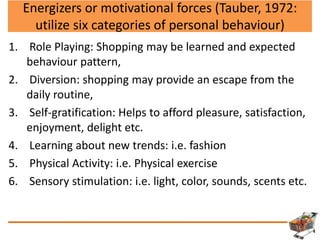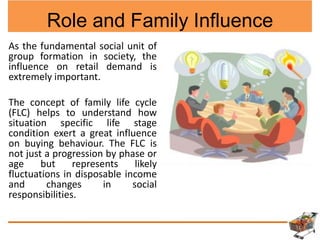Consumer Behaviour & Retail Operations
- 1. Consumer Behaviour And Retail Operations B.B.A . – 8th Sem. By Mr. Navin Raj Saroj M.B.A. (Marketing) Retail Marketing Management
- 2. The Term consumer behaviour is defined as the behaviour that consumers display in searching of, purchasing, using, evaluating and disposing of products and services that they expect will satisfy their needs. Consumer Behaviour focuses on how individuals make decisions to spend their available resources (time, money, offers) on consumptions – related items. That includes w/h questions about buying patterns.
- 3. Why Need to Study Consumer Behaviour ? Because no longer we take the customer/consumer for granted, Many variables will influence the way consumption patterns differ. There will change based upon the different types of retailers in the market place and the way individuals have learnt to approach purchase opportunities.
- 4. Needs, Wants and Demand Functions For the Purchase Process Motivation Characteristics Needs Basic human requirements. That pre-exit with consumer i.e. need air, food, water, clothing, and shelter to survive. Wants Needs becomes wants when they are directed to specific objects that might satisfy the needs. i.e. consumer needs food but may want a hamburger. Demands Demands are wants for specific products backed by an ability to pay.
- 5. Purchase Process The purchase process has been influenced by marketers to ensure that products and brands are chosen to create a social comparison between the purchaser and others. Retail Service Merchandise / Visibility Offer Other Stimuli (Marketing / Friends etc) Person or Group making purchase decision (Buyer characteristics and evaluation criteria) Product purchased or not purchased (buying roles as to product choice, brand choice, timing of purchase, cost alternative sough
- 6. Time taken to Shop:- There are differences in the type of shopping behaviour embarked upon. i.e. sometimes a shopping trip is merely a functional or complex activity whereas at other times it will be a leisure activity. Model of Time related shopping expeditions: Functional (Time Efficient) Complex (Time Required) Leisure (Time rich activity) Focused Predetermined ……Pre-planned/researched…….Emphasis on browsing Routine habitual action higher risk and serendipity
- 7. Retail fashion buying process; Snyder and Fromkin (1980): Humans strive towards individuality (uniqueness) and conformity in appearance There are three theoretical approaches that may explain the way by which adoption processes for fashion occur in retailing: 1. Trickle- down theory: New and innovative fashions and styles originate for the Higher Classes and passed down through middle classes, 2. Trickle –up theory: A process of fashion and style creation by lower socio-economic groups which is followed by the upper classes prior to being adopted by the middle classes. 3. Trickle –across theory: Fashion and style can originate in any one of the social classes. Opinion leaders of any group can take up the fashion development then that fashion and style is more likely to be adopted.
- 8. Retail Buying Roles • Choices over purchase are subject to a vast number of forces acting collectively. Buyer Role Characteristics Initiator First individual who suggest product/service should be evaluated/purchased, Influencer Provides views and advice which are valued by others and can subsequently influence the final decision, Decider The individual who will take the decision in the buying process as to w/h to buy (Store choice) etc. Buyer The individual who actually makes the purchase User The individual who consumes or uses the service/product
- 9. Kelly and Stephen (1967) identified Eight dimensions in Retail store choice: 1. General Store Characteristics (reputation, number of stores), 2. Physical characteristics of the store (decor, cleanliness, checkout services), 3. Convenience of reaching the store, 4. Products offered (variety, dependability, quality), 5. Price charged by the store (value, special sales), 6. Store personal (courteous, friendly, helpful), 7. Advertising by the store (informative, believable, appealing) and 8. Friends perception of the store (well known, liked, recommended).
- 10. COMPARISON OF BEHAVIOURIST AND COGNITIVIST APPROACHES Behaviourist (One who study behaviour of human):- Observed behaviour is all important, Behaviour is predictable, People are information transmitters, People are all alike, Behaviour is rational, Human characteristics can be studied independently, Emphasis is on what a person is and does, Behaviour can be understood. Cognitivist (the part of mental functions that deals with logic as opposed to affective which deals with emotions) :- What goes on in a person’s mind is the key to comprehension, Behaviour is not predictable, People are information generators, Each person is unique, Behaviour is irrational, People must be studied as a whole, Emphasis is on what person can be, Behaviour can never be completely understood.
- 11. Consumer Decision Making Process
- 12. The Engel – Kollat – Blackwell (EKB) Model: Perception and Learning based Problem Recognition/arousal, Internal search – Alternative Evaluation, External Search – Alternative Evaluation, Choice /Purchase, Outcomes as dissonance or satisfaction Leon G shiffman & Lasile L Kanuk: • Need Recognition, • Pre-purchase search, • Evaluation of Alternatives • Purchase: Trail Repeat Purchase • Post Purchase Evaluation, • Experience Decision Making Process
- 13. • The environmental factors such as cultural norms and values, motives etc. which influence these stages are important. The model incorporates influence which moves from the general to the specific, which is from the macro level (reference group, social class, norms) to the micro level (belief, intention, attitude).
- 14. Seth’s Family Model of Behaviour for Decision Making Mass Media Word of Mouth Display Sources of Information Overt Search Sensitivity Of Information Perceptual Bias Evaluative Beliefs Buying motives Pre disposition of Father Pre disposition of Mother Pre disposition of Other members Members Family Buying Decisions Joint Decision Autonomous Decision Family Household Unit
- 15. Retail Buying Process : Eight - Stage Model 1. Need Arousal 2. Recognition of the Need 3. Level of Involvement 4. Search of Information and Identification of Alternatives 5. Evaluation of Alternatives 6. Decision 7. Purchase Action 8. Post Purchase feeling / Behaviour
- 16. Kind of Risk at Retail Products : Economic Risk : i.e. Value of Product, Financial risk Physical Risk: i.e. Fear through products (electrical, Medicines) Psychological Risk: i.e. Product image which reflects personality Performance Risk: i.e. Desired Expectations from Retail products
- 17. Influences on the Consumption Process Energizers of Demand: Forces of motivation that lead a potential consumer to decide upon a shopping visit or to seek out a product. Filterers of Demand: Factors which affects for buying i.e. Economic factors (social class and disposable income), sociological factors (reference group) and psychological factors (perception of risk, personality, attitudes). Effecters: an effecter could be the position, display and type of merchandise which creates an impulse purchase. Roles: (family influence, cultural influence)
- 18. Energizers or motivational forces (Tauber, 1972: utilize six categories of personal behaviour) 1. Role Playing: Shopping may be learned and expected behaviour pattern, 2. Diversion: shopping may provide an escape from the daily routine, 3. Self-gratification: Helps to afford pleasure, satisfaction, enjoyment, delight etc. 4. Learning about new trends: i.e. fashion 5. Physical Activity: i.e. Physical exercise 6. Sensory stimulation: i.e. light, color, sounds, scents etc.
- 19. Social Motives behind Shopping 1. Social Experience Outside the Home: 2. Communication with others having a similar interest: 3. Peer group attraction: 4. Status and authority: 5. Pleasure of Bargaining: Patronage of Retail Outlet: Convenience, Reputation, retail Environment Characteristics, Service encounter expectations, Expectations of the merchandise, Expectations of Value.
- 20. The Motivation Process • Motivation refers to the process that leads people to behave as they do • It occurs when a need is aroused • The ad shows desired state and suggests a solution (purchase of equipment)
- 21. Maslow’s Hierarchy of Needs
- 22. Market Segmentation Geographic Region, City, Rural and Semi urban areas Demographic Age, Family size, Gender, Income, Occupation, Education Psychographic Socio Economic Classification (SEC), Lifestyle, Personality Behavioral Occasions, Benefits, User status, Usage rate, Loyalty status, Readiness stage, Attitude toward product
- 23. SOCIO – ECONOMIC CATEGORIES A. Upper middle class : higher managerial/administrative or professional e.g. doctor, director B. Middle Class : Intermediate manager / administrative or professional C1. Lower Middle Class : Supervisory / clerical / junior managerial / administrative C2. Skilled working Class: Skilled Manual worker D. Working Class: Semi skilled or unskilled worker E. Lowest level of subsistence: Pensioners, casual worker, widows and others
- 24. Role and Family Influence As the fundamental social unit of group formation in society, the influence on retail demand is extremely important. The concept of family life cycle (FLC) helps to understand how situation specific life stage condition exert a great influence on buying behaviour. The FLC is not just a progression by phase or age but represents likely fluctuations in disposable income and changes in social responsibilities.
- 25. Wells and Gubar (1966) conceptualized the Life Cycle of Families in USA 1. Bachelor Stage, 2. Newly married couples, 3. The Full Nest - 1, 4. The Full Nest – 2, 5. The Full Nest – 3, 6. The Empty Nest – 1, 7. The Empty Nest -2, 8. The Solitary survivor – 1, 9. The Solitary survivor – 2,
- 26. The role of children in the consumer behaviour process The child eventually becomes a dominant force in certain purchasing decision. Companies target children at an early age so as to build brand loyalty. i.e. Teeth related product, their TV Ad, Noodles, Biscuits Ad etc.
- 27. Social Influence / Reference Group The family may introduce political ideas and consumer attitude to purchasing to the children. However, the reference group of the individual is just as important. Purchases take place on the basis of thinking about the way purchase may help provide status within the group, how the purchaser may need to consider other members and what messages the purchase communicates to those from whom and individual wants recognition and acceptance.
- 28. Types of Reference Group 1. Primary Reference Group: i.e. family, close friends, co- workers, 2. Secondary Reference Group: i.e. Formal contact but less continuous – Club members 3. Aspirational Group: i.e. Influence with personality and consider a member, 4. Dissassociative Group: i.e. individual does not want to be associated.
- 29. END





























